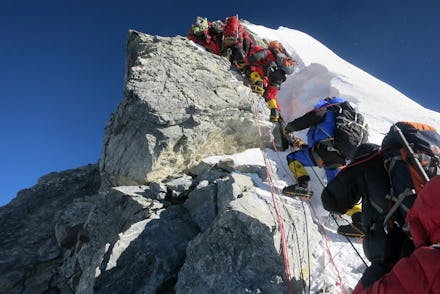After Everest's Deadliest Avalanche, Sherpas Have Finally Had Enough

The news: Planning a trip to Mount Everest this year?
Image Credit: AP
You may be in for a surprise. Impending boycotts could shut down the world's highest peak for an entire climbing season, losing the Nepalese government over $3.3 million in permit fees.
The reason is simple: Last Friday became the deadliest day in the mountain's history when an avalanche killed 16 mountaineers. Thirteen bodies have since been recovered, with the other three "permanently entombed in ice."
Image Credit: National Geographic
Image Credit: AP
What's striking about this tragedy is that all the victims were Sherpas — native Nepalese climbers paid to chart routes, fix rope, carry gear and set up camps for foreign thrill-seekers and adventure tourists. Their deaths have sparked a nationwide outcry, and raised questions around fair compensation and the historical inequalities that define their work.
Image Credit: AP
It's an issue that goes back almost 100 years. When Gregory Mallory attempted the "first serious" ascent of the mountain in 1922, seven Sherpas were killed in an avalanche. Yet ever since Tenzing Norgay joined Sir Edmund Hillary as the first people to reach the summit in 1953, Sherpas have been vital fixtures of nearly every expedition.
In terms of compensation, Sherpas make out like bandits compared to the typical Nepalese worker. A top guide can clock $6,000 over a three-month period, nearly 10 times the national average of $700 a year. They are well aware of the risks surrounding their profession and participate voluntarily — that is, if the choice between $174 and $6,000 in three months can be called "voluntary."
But lately, there's been trouble in paradise. A 2013 incident involving a violent scrum between Sherpas and three European mountaineers drew international attention to the arrogance and disrespect guides often face from foreign tourists. This is exacerbated by the fact that the Nepalese government demands hefty fees from would-be climbers, very little of which trickles down to Sherpas.
Most importantly, the dangers inherent to Sherpas' duties have become increasingly pronounced with time. When leading an ascent, they are exposed to the most deadly regions of the mountain, which they're charged with making safer and more navigable for clients. The result is a sobering 1% mortality rate and cumulative death toll that far outstrips most high-risk jobs — including being a soldier in Iraq between 2003 and 2007:
Image Credit: Quartz
Grayson Schaffer of Outside magazine observes: "If, say, 1% of college-aged raft guides or ski instructors were dying on the job ... the guiding industry would vanish."
He adds that "no service industry in the world so frequently kills and maims its workers for the benefit of paying clients."
Considering all of this, last week's deaths were the icing on the cake. Sherpas are now demanding the Nepalese government double the minimum insurance payment for fallen climbers to $20,800. They also want greater regulation, aimed at protecting and fairly compensating them in an industry that profits handsomely from their labor. "The government has made no big response even after a big tragedy like this," says Sherpa Pasang of the Nepal National Mountain Guide Association. "Until they hear our pleas we will continue to put pressure."
In the meantime, officials have agreed to set up a fund for fallen Sherpas, and the Sherpa community plans to implement a season-long boycott against climbing the mountain in honor of their fallen comrades. Yet whether or not both sides agree on new terms, one fact remains: Approximately 200 lives have been lost so far scaling the world's tallest mountain. It's an incredibly dangerous endeavor, and as long as people are driven toward braving its peak, more Sherpas and climbers will inevitably die on its slopes.